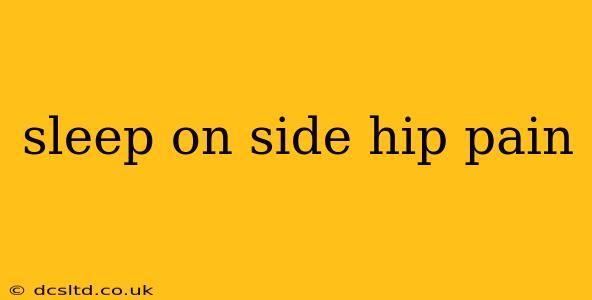Side sleeping is a popular sleep position, favored by many for its comfort and perceived benefits. However, for some, this position can exacerbate existing hip pain or even cause new discomfort. Understanding the causes of hip pain while side sleeping, and implementing strategies for relief, is crucial for a good night's rest. This comprehensive guide will explore the common causes, offer solutions, and address frequently asked questions surrounding hip pain and side sleeping.
Why Does My Hip Hurt When I Sleep on My Side?
Hip pain during side sleeping can stem from various sources. Underlying medical conditions often play a significant role. These include:
- Bursitis: Inflammation of the bursae (fluid-filled sacs) that cushion the hip joint can cause sharp, localized pain, worsened by pressure during side sleeping.
- Tendinitis: Inflammation of the tendons surrounding the hip joint, often due to overuse or injury, may cause pain and stiffness aggravated by pressure while sleeping on your side.
- Osteoarthritis: The degeneration of cartilage in the hip joint can lead to pain and stiffness, making side sleeping uncomfortable.
- Hip Labral Tear: A tear in the labrum (cartilage ring around the hip socket) can cause pain, clicking, and locking, often exacerbated by specific sleeping positions.
- Sciatica: Irritation of the sciatic nerve can radiate pain down the leg, and certain sleeping positions, including side sleeping, can worsen this pain.
- Muscle Strains or Spasm: Overexertion or improper posture can lead to muscle strains or spasms in the hip and surrounding areas, causing pain when pressure is applied during sleep.
- Pregnancy: Hormonal changes and the weight of the growing baby can strain the hips, leading to increased pain while sleeping on the side.
What Can I Do to Reduce Hip Pain While Side Sleeping?
Fortunately, several strategies can help alleviate hip pain associated with side sleeping:
-
Proper Sleep Posture: Sleeping on your side with your knees slightly bent and a pillow between your knees can help align your hips and spine, reducing strain. Adding a pillow under your top leg can further support hip alignment. Experiment with pillow placement to find what's most comfortable.
-
Choosing the Right Mattress: A medium-firm mattress offers the best support for hips and reduces pressure points, improving comfort. Avoid overly soft mattresses that may sink and misalign your spine.
-
Using a Body Pillow: A body pillow can provide additional support and cushioning for your hips and legs, distributing pressure more evenly and reducing strain.
-
Stretching and Exercise: Regular stretching and strengthening exercises, particularly those targeting the hip flexors, glutes, and core muscles, can improve hip mobility, stability, and reduce pain. Consult a physical therapist for a personalized exercise plan.
-
Pain Relief Medication: Over-the-counter pain relievers like ibuprofen or naproxen can help manage pain and inflammation. For more severe pain, consult a doctor for stronger pain medications or other treatment options.
-
Heat or Ice Therapy: Applying heat or ice packs to the affected hip area can reduce pain and inflammation. Experiment to see which works best for you. Heat is generally better for stiffness, while ice is better for acute inflammation.
-
Sleeping on Your Back: If side sleeping consistently causes hip pain, consider trying to sleep on your back. This position might put less direct pressure on the hip joint, though it might require the use of pillows to support your neck and back.
What Are Some Other Causes of Hip Pain?
Beyond sleeping positions, other factors contribute to hip pain:
- Injury: Falls, sports injuries, or trauma can cause hip pain and discomfort.
- Infections: Infections in or around the hip joint (septic arthritis) can cause severe pain.
- Medical Conditions: Conditions like rheumatoid arthritis and ankylosing spondylitis can impact the hip joints.
- Obesity: Excess weight puts extra pressure on the hips, leading to pain and discomfort.
How Can I Prevent Hip Pain While Side Sleeping?
Prevention is key! By addressing potential issues proactively, you can minimize the risk of hip pain:
- Maintain a Healthy Weight: Maintaining a healthy weight reduces strain on the hips.
- Regular Exercise: Incorporate regular low-impact exercises to strengthen hip muscles and improve flexibility.
- Good Posture: Practice good posture throughout the day to reduce strain on your hips and spine.
- Proper Warm-up: Always warm up before any physical activity to prepare your muscles and joints.
- Seek Medical Attention: If you experience persistent hip pain, consult a healthcare professional for proper diagnosis and treatment.
When Should I See a Doctor for Hip Pain?
Consult a doctor if you experience:
- Severe hip pain that limits your mobility
- Sudden onset of hip pain
- Hip pain accompanied by fever or chills
- Persistent hip pain despite trying home remedies
This information is for general knowledge and does not constitute medical advice. Always consult with a healthcare professional for any concerns regarding your health. They can provide a proper diagnosis and develop a personalized treatment plan for your specific situation.
